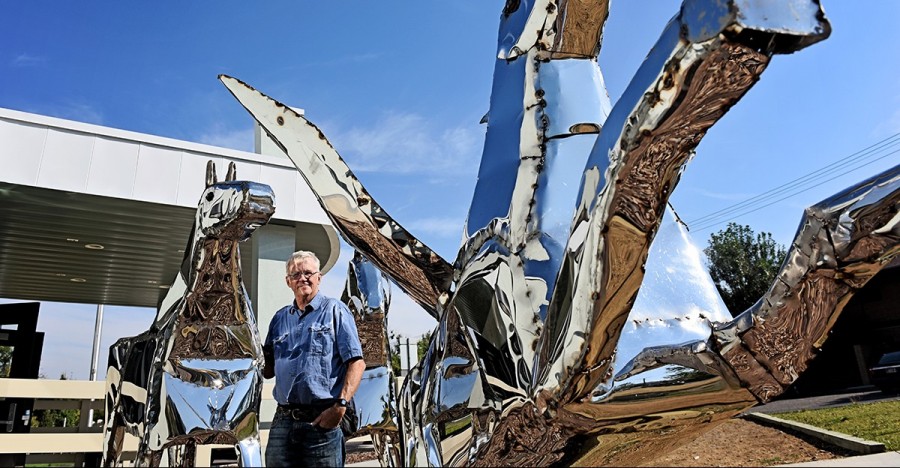Creativity is always a leap of faith. Writers sit down in front of empty pages. Painters stare before blank easels. Thespians rehearse looking toward empty stages.
Metal artist Bill Ryder’s leap of faith is experimental by nature. He explores his creativity with Smith Corona plug-in typewriters, antique Dromann seam machines, silvery cable chains discovered at garage sales, sheet metal from Pacific Steel, and the curved internal organs of 8 mm projectors purchased from thrift shops. His leap of faith is as much self-exploration as it is the celebration of the torch flickers and vintage portions all part of the process.
“You just need to get a whole bunch of stuff together, start making it, be brave, and whack it up,” said Bill Ryder, noted primarily for this metal horse sculptures.
In the yard of his Helena home, there are plenty of unique materials waiting to be repurposed into welded metal art: small packages of fixtures picked up at the estate sale of a former plumber; tire chains to eventually be re-used as part of a horse mane; heavy steel bicycle parts, pawn shop rescued tools; Domestic Rotary antique sewing machines.
“I try to stock up on the castoffs,” said Ryder. “A lot of this stuff you can get on Sunday half price at estate sales. But if you want the good stuff – like some of the sewing machines – you have to step up. This one cash register down here has so many different pieces, buttons, and great linkages.”
Bill’s welded metal artistry is a family affair, for he is joined by his wife, Julie, on projects. The pair often place driftwood in the scaffold of his larger horses. Bill collects the driftwood and Julie positions it. Some of their horses are embedded with more reflective items, such as a deceased lineman’s belt buckle or military insignias or mementoes.
All Ryder horses begin with steel telegraph wire, copper coated welding rod, or electric fence wire. After the heat of the torch attaches the frame, it can be filled in with various kinds of rusty, vintage ingredients. Sometimes Bill will wrap brass or ceramic around the steel framework of the horse and weld them. No matter what is applied inside or to the exterior, the finished product is handsome, strong, and immortal.
Perhaps the immortality of the work stems from the fact that the Ryders do not believe in the idea of a useless mechanism. In their estimate, there is nothing obsolete about a broken contraption. If a machine no longer clicks or whirs, it is still a beautiful piece of equipment chock-full of complex mechanics. Indeed, old devices provide simple artistic solutions, both the questions and answers.
“Finding a lot of the old beautiful stuff has a lot to do with perseverance,” said Bill. “With welding and repurposed art, I can create it as fast as I can think about it. With welding, I just do it. If I don’t like it I can cut a chunk off. It’s not pottery or something that you have to wait three weeks for.”
During outings to antique stores, junk shops and garage sales, the Ryders discover items that they perceive as all part of a continuum; the artistic force in question is perpetuity, the eternal mode of expression, the deliberation of past, present and future. Typewriter parts receive special consideration.
“I make frequent stops at the thrift stores looking for typewriters,” said Bill. “If they are nothing special, like mid-1950s, they are sadly just thrown into the metal recycling.”
Bill said that most of the pieces he cannibalizes for parts hold more of an intrinsic value than a financial one. But even if that were the other way around, he said he would still dissect them.
“I picked up this old black typewriter once,” said Bill. “And as rare as I thought it was, it was selling for $12 as a collectible on EBay, with free shipping. There are millions of them – old typewriters. So I just go ahead and use them. They might as well be reborn into something else, something that will stay around.”
The son of a mechanic, Bill Ryder’s passion took on a decidedly repurposed quality years ago when a momentary respite from the daily grind allowed him to better focus on the medium of sculpture. Torch in hand, auto-darkening helmet clamped around chin, he began creating unique “assemblages” and horses made of inexpensive vintage finds and old unwanted objects. He packed his frames – mostly ones resembling horses, ranging from miniatures to ten feet tall – tight with mechanical density. He raised enough interest to warrant teaching welding and art classes.
Bill chuckled as he recalled a recent welding class he instructed in Lewiston; the class focused on the construction of small-form horses.
“The folks in Lewiston were pretty eager,” said Ryder. “It was supposed to be for the basic beginner. You know, really easy and small stuff. You give them options,small things, dead parts and pieces, horseshoes. Some of the folks got really excited, and they started dragging in old car frames and big things.”
Bill Ryder is a bit of a freestyle creative entrepreneur. He’s a businessman when he has to be. Half the time he has to concentrate on the business end, but generally he is most comfortable when his creativity is at the forefront. Holding a box of wooden white piano keys, Ryder contemplates their future insertion. “I am sure I will find a project for that.” He picks up a helical scan reader yanked from the guts of a VHS recorder. “You couldn’t create that,” he says. “Maybe you could. But it would take a lot of time. I’m going to take it ,and it will become something more when it is put inside of something else.”
Originality is the essence of Ryder’s veritable scholarship. Creativity is his soul. His degree is in the resurrection of memories and the belief in nostalgia; some of the best things in life are those forgotten trinkets you have to go digging around for in a closet corner or on a sandy shelf in the attic.
“So many of the parts would be part of something that would be ordinarily sitting around collecting dust somewhere,” said Bill. “After I get done with them, they are part of a horse – a piece of art – that people can pass on to their kids.”

